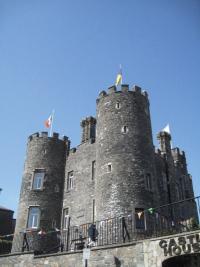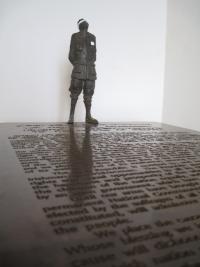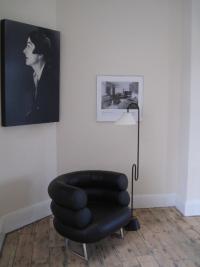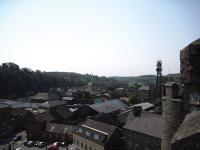Enniscorthy Castle Castle Hill, Enniscorthy, Co. Wexford
Published in 18th–19th - Century History, Early Modern History (1500–1700), General, Issue 6 (Nov/Dec 2011), Medieval History (pre-1500), Reviews, Volume 19
Enniscorthy Castle—used to house the unofficial Wexford county museum. The visitor can now appreciate the castle and its own history.
I can remember when the castle in Enniscorthy housed the unofficial Wexford county museum. It had all the attractions and flaws of a volunteer-run museum, with every room packed with exhibits, not always in the best of condition. In 2006 the castle was closed for major renovation. A radical decision was taken to concentrate on the castle and its history. The original collection was removed for professional conservation and storage. The plan is to divide it up among appropriate local institutions—the 1798 artefacts, for example, going to the nearby National 1798 Visitor Centre.The visitor can now appreciate the castle and its own history. There are three floors open to the public, given over to historical exhibits and rooms recreating the castle of a century ago. The dungeon is worth looking at for the large graffito scratched into a wall and tentatively identified as an Elizabethan halberdier. Using large information panels, maps and artists’ impressions, the ground floor relates the history of Enniscorthy from when it was the seat of Irish kings to the arrival of the Normans and beyond. The present castle was built in the 1580s by Henry Wallop and is probably modelled on the much older castle at Ferns. There is one display cabinet that gives a flavour of the old collection, with its eclectic mix of Stone Age tools, a model of a steam lorry, a ceremonial sword of the Order of St Patrick and so on.For many decades the castle was the home of the local Roche family, who rented it from the earl of Portsmouth. Previously it had housed the earl’s agents and had been used as offices or storerooms for some local businesses. The Roches took it over and turned it into a surprisingly cosy home. Their sitting-room, bedroom and children’s playroom are recreated with tables, beds, chairs, bookcases and so on from the early twentieth century with the aid of original photographs. Look out for the music box, sofa and bed in particular.

The Proclamation by Rowan Gillespie (bronze, 2009)—one of the exhibits in the 1916 Room.
The furniture is enhanced by panels that carry reminiscences from those who actually lived in the house, recalling everyday life, family treats, Christmas and so on. Photographs on the panels show not just the castle but also the people who lived there, giving an intimate atmosphere to the rooms. Interestingly, the Roches had connections to the American Shriver family. This is reflected in the photographs of visiting American relatives and trips to the US. One evocative photograph of the latter shows the children with Baba, a Shriver family servant described as a ‘freed slave’. Taken in the early 1900s, it brings home that we are just a few generations removed from slavery in America.
Upstairs there is an exhibition on the 1916 Rising. Outside of Dublin, Enniscorthy was the largest urban area to be taken by rebels and the last place to surrender. Again large panels explain the origins and day-by-day course of the Rising in the town. The castle itself was one of the strongholds taken by the Volunteers. Display cabinets contain artefacts such as uniforms, weapons, field glasses and even the flag of the Enniscorthy Volunteers. Most noteworthy are the letter of surrender from Pearse to the local rebels and the examples of scrimshank, carved fragments of bone, produced by Wexford rebels imprisoned in Frangoch concentration camp.I have to admit that I was taken by surprise by the permanent exhibition in the next room. There were ultra-modern chairs and tables made of glass and tubular steel. These, however, date from the 1920s and 1930s and are the work of Eileen Gray. I knew that this world-famous designer was Irish but had no idea that she was born and raised just outside Enniscorthy. Gray spent most of her adult life in Paris, but it seems that her hometown has not forgotten her and the refurbishment of the castle provided the perfect opportunity to pay tribute to her.

A replica of the distinctive 1920s ‘Bibendum’ chair in the Eileen Gray exhibition, inspired by the Michelin tyre company mascot, ‘Bibendum’, a.k.a. the ‘Michelin Man’.
Visitors can walk around the castle themselves but I recommend going on one of the guided tours, and not just because this is the only way to get out onto the roof for views of the town and surrounding countryside. The young, enthusiastic guides don’t just repeat what is on the panels but give their own interpretation of the castle’s history and the objects on display. You will not only be entertained but better informed too.The decision to go in this direction with the castle was a bold one and it has worked. As it is now, it is a more enjoyable experience than when it housed the museum. You not only learn more about the history of the town and its castle but also appreciate the architecture of the building. The cosiness of a century ago is restored, while the exhibits on 1916 and Eileen Gray add depth. Nevertheless, this development does raise the question: is Wexford now left without a county museum? HI

A replica of the distinctive 1920s ‘Bibendum’ chair in the Eileen Gray exhibition, inspired by the Michelin tyre company mascot, ‘Bibendum’, a.k.a. the ‘Michelin Man’.
















